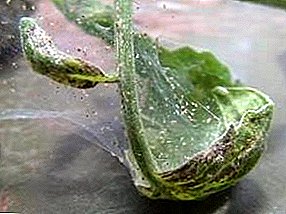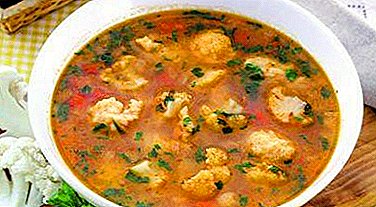 Today there are many breeds of chickens, the records of which are already difficult to surprise experienced and qualified poultry farmers. Nevertheless, there are chickens Brown Nick, which, thanks to high productivity, excellent taste of eggs, their optimal shape and weight, as well as their versatility in content, farmers and scientists are truly impressive.
Today there are many breeds of chickens, the records of which are already difficult to surprise experienced and qualified poultry farmers. Nevertheless, there are chickens Brown Nick, which, thanks to high productivity, excellent taste of eggs, their optimal shape and weight, as well as their versatility in content, farmers and scientists are truly impressive.
What else admire these cross-record breakers, let's look at.
Origin
Chickens Brown Nick were brought to the territory of the post-Soviet countries from Germany. The beginning of the selection of the brown hen is dated to 1965, when the breeders of the German corporation "H & N International" were given the task to raise a breed of chickens that is characterized by high egg production rates, good resistance to the most common diseases, undemanding in food.
As a result of successful breeding, scientists received a new, highly productive cross, the benefits of which were first to be appreciated by German farmers. A few years later this breed became available worldwide.
In order to obtain eggs, hen are bred "Brekel", "Hisex Brown" and "Hisex white", "Shaver," Leghorn "," Iza Brown "," Loman Brown "," Russian White "," Ukrainian Ushanka "," Orlovskaya "," Pavlovskaya "," Minorka "," Pushkinskaya ".Most poultry farmers are confident that Brown Nick is the best option for farming, since it allows for about 400 eggs a year, while very quickly covering the costs of laying hens.

External characteristics
Chickens Brown Nick differ quite large, massive physique, weighing from 1.7 to 3 kg, depending on gender. A feature of the breed is its autosexuality, that is, the possibility of finding out the sex of a bird at the age of one day.
When breeding birds, it is important to be able to determine the age of the chicken.
Roosters
Daily marshies are distinguished by their uniform white color, on which fuzzy stripes of dark shades can sometimes appear. Adult individuals are also white, have a large body of a trapezoidal shape with a clearly delineated chest and a beautiful long tail, an average head in size, on which a large, upright, leaf-like crest of rich red tone stands out.
Rooster catkins are large, oval-shaped and bright red in color. The beak is of medium length, slightly curved, painted dark brown on the top, gray-yellow from the bottom and on the sides. Males have rather large, powerful four-fingered limbs, tarsus are average, gray in color. The weight of an adult rooster averages 2-2.5 kg.

Did you know? Chickens hatch all the eggs, both their own and others, without making a distinction between them.
Chickens
Chickens can be identified by a light brown color, with possible white patches. They have a more miniature physique in the form of a trapezoid, to which small wings fit tightly. The head of a chicken is small, with an erect, medium-sized, leaf-shaped comb of bright red color and neat beak of grayish-yellow shade.
Earrings - small, oval-shaped, bright red colors. Limbs in females of medium size, four-fingered, without plumage, tarsus - gray. The weight of an adult chicken varies in the range of 1.7-2.2 kg.
Character
Like all representatives of Germany, Kick Brown Nick is characterized by a calm and restrained disposition. They:
- quite modest;
- do not show aggression. Roosters in rare cases, get into fights, not aggressive, do not provoke scandals;
- peaceable;
- are highly resistant to stress;
- not shy;
- perfectly adapted to a sedentary lifestyle.

Important! Chickens Brown Nick better tolerate low, cold temperatures than heat, which reduces egg production and become susceptible to various kinds of ailments.In addition, the birds of this breed are distinguished by good resistance to the harsh climate, they perfectly adapt to any conditions. If they provide regular walking, then the chickens are able to behave quite actively.
Productivity
Brown Nick belongs to the egg species, therefore, has excellent performance indicators. The parameters of egg production will depend on the age of the chicken and its weight. The productivity indicators are presented in the following table:
| Bird Age (weeks) | Bird weight (kg) | Number of eggs per year | Egg weight (g) |
| Up to 60 | 1,6-1,8 | 255 | 60 |
| 60-80 | 1,8-2 | 360 | 60 |
| 90 | 2-2,2 | 400 | 70 |
The maximum peak of productivity in chickens comes in the first 1.5 years of their life. They begin to rush at the age of 5-6 months, and eggs are laid regularly, year-round. Eggs have a durable brown shell, which greatly facilitates the process of their transportation and storage.

If we talk about the instinct of the hen, then in the hens of this breed it is very poorly developed. That is why for breeding high-quality young need an incubator.
Did you know? Brown Nick Hens Eggs possess one of the most amazing features. They completely lack the fishy smell that is inherent in eggs of other breeds.
What to feed
Despite the fact that Brown Nick is not picky about food, they need to organize a full, balanced diet in order to ensure regular egg-laying.
Wet mash
Unpretentiousness in the diet allows the birds to add literally everything that is at hand. Chickens with pleasure enjoy the wet mash prepared on the basis of broth, skim milk or ordinary boiling water.
It is recommended to add foods rich in vitamins and minerals: vegetables, fruits, grass meal. As a rule, mash from mixed fodder, boiled beets, carrots, vitamin premixes are given in the morning.

At the age of one week, youngsters need to be fed up to 5 times a day, using small cereals (semolina, corn, yachchnyak to germinate wheat for laying hens, th) mixed with boiled cereals. One-month chicks are transferred to more solid food by adding a flattened grain to the diet. At the age of 6 weeks, laying hens are accustomed to adult food and transferred to three meals a day.
Learn how to germinate wheat for chickens, what is the rate of feed for layers for a day, what vitamins are needed for egg production, how to contain layers, how to make feed for laying hens.
Vegetables
Given the high activity of the bird, it is necessary to include in its diet vegetables and fresh greens, which contain a large amount of useful vitamins and minerals. Chickens will not give up beets, carrots, tops of plants, nettles.
It is important to enrich the menu of birds with various mineral and vitamin complexes, the lack of which can adversely affect the process of egg formation and the health of chickens.

Meat waste
Birds are important not only vitamins, but also trace elements, especially protein and calcium. Their deficiency can trigger the development of various diseases in chickens, as well as reduce the quality of eggs. Meat and fish waste, dairy products are considered to be an excellent source of protein and calcium. If possible, it is recommended to "pamper" layers with maggots and worms. In addition to pantophagy, this breed has a low feed intake rate. So, for an adult individual you will need only 100 g of feed per day.
Find out whether it is necessary to have a rooster, why chickens peck eggs, carry small eggs, what to do to make chickens rush in winter, how to check the freshness of eggs.The approximate diet of poultry grown in private households per day looks like this:
- cereals: wheat, oats, barley (dry or germinated);
- mash: based on vegetables or feed;
- sunflower seeds;
- fresh grass, greens;
- vitamin premixes.

It is very important to provide the layers with constant access to clean water. To do this, drinkers regularly filled with fresh water.
Maintenance and care
The performance of chickens, their health and activity are directly determined by the conditions of their maintenance and competent care.
Light mode
The intensity of daylight and its duration are influenced not by the formation of the young and the egg production of adult chickens. Care should be taken to follow the guidelines for laying hens. On average, birds require a 14-16-hour daily light regime.
Important! Since the Brown Nick hens are rushing year-round, regardless of the season, they need to maintain adequate lighting all the time.

It is recommended to arrange lighting for birds, according to their age:
- "newborns" (1-3 days): the illumination coefficient is 10 lux, the duration of the day is around the clock;
- monthly chicks (up to 30 days): 10 lux and 16 hours, respectively;
- from 30 days to the first laying: up to 7.5 lux and 9 hours;
- during intensive egg-laying: up to 7.5 lux and up to 16 hours.
The room
For chickens of Brown Nick breed is acceptable as the content in the cages, and in a spacious chicken coop. However, it is very important to keep the room clean, hygienic, and the required temperature.
Harsh climatic conditions are not an obstacle to the breeding of birds, but it should not be allowed to lower the thermometer in the coop below + 5 ° C. Walking the hens in cold season is contraindicated, as they can catch a cold and freeze the comb.
Learn how to make a chicken coop, ventilation, nest, roost, heating yourself.

The most comfortable temperature in the room is + 21-25 ° C. It is important not to allow drafts in the hen house. When growing birds, it is necessary to respect the ratio of individuals per square meter.
At the floor the maximum number of chickens per 1 square. m. makes 13 units of young animals and 7 units of adult individuals, with a cage - for one chicken it will take 1.42 square meters, for an adult chicken - 2.84 square meters. If these proportions are not observed and the birds are oppressed, then various diseases can arise against the background of overheating.
Calculation calculation
When forming a family, as a rule, 10-15 layers are placed on one rooster. Such a ratio makes it possible to create a calm, peaceful and quiet atmosphere in the hen house, as well as to achieve optimal indicators for laying eggs in chickens. The rooster imposes order in the house, protects his “wards” and controls their behavior.
Birds can be perfectly carried without the “leader”, but its presence allows to obtain high-quality, fertilized eggs.

Advantages and disadvantages
Brown Nick is an excellent, highly productive breed of layers, in which farmers have many advantages:
- calm, peaceful temper;
- high egg production rates, about 400 eggs per year;
- excellent survival rate of young stock, over 98%;
- both cell and floor contents are acceptable;
- high quality eggs, no fish smell, very durable shells;
- low feed costs.
Important! It is recommended that this breed of chickens be kept for no more than three years, since at a higher age their productivity indices are significantly reduced.Brown Nick is a unique breed of chickens that, with proper care, is able to please with record egg-laying rates. Birds have a very calm, peaceful nature, are well tolerated by any conditions of housing, unpretentious in feeding, which makes the process of breeding layers not only simple, but also very pleasant for every farmer.
Chickens Brown Nick: video
Chickens Brown Nickname: reviews
For example, when we ran out of feed for PC-1 layers Istra-bread product (700r - 40 kg), we bought cheap feed for layers (330r - 30kg), the chickens stopped on it to be carried for 7-10 days.
When we were able to feed them again with good feed, then after 5-7 days the chickens were brought in as before (now this cellular content without walking, since we are in the process of construction).
For eggs in the composition should be: fish, meat, as well as chalk, shell rock, crushed egg shell, some of these ingredients must be ...


A couple of years ago I took Brown Nick (4 months) in Shpitkah, after 2-3 weeks they brought it in, rushed almost all year round, with a rest during shedding ... there are still a few pieces left, rushing every other day.













